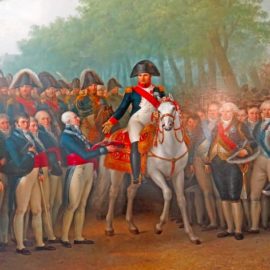
What can we learn from An Indigenous Peoples’ History of the United States? What perspectives have been left out of most American history books?
An Indigenous Peoples’ History of the United States tells the story of how Native American nations have struggled to survive throughout the European colonization of America. This history is extremely important to make sense of the current status of indigenous nations.
Read on to learn about indigenous American nations and how they have survived and developed since European colonization.
About An Indigenous Peoples’ History of the United States
Some experts criticize US history books for centering white Americans’ point of view at the expense of native perspectives. Historian Roxanne Dunbar-Ortiz remedies that in her 2014 book An Indigenous Peoples’ History of the United States, a retelling of US history that prioritizes the experiences of Native Americans. Dunbar-Ortiz is also an activist, professor, and author of other historical works that focus on Native perspectives, including The Great Sioux Nation and Loaded.
In this book, Dunbar-Ortiz weaves together two major arguments: First, she says the US’s success in rising to independence and becoming a global superpower can be traced directly to the genocide it committed against Native Americans. Second, she says the tradition of indigenous resistance holds the key to a more peaceful future. In our guide, we’ll discuss how each of these patterns (genocide and resistance) played out across several epochs of American history:
Before Colonization: We’ll discuss Native American life before colonization and explore some of the historical processes that led Europe to colonize the Americas.
The Colonial Period: We’ll explain how British settlers used genocidal warfare tactics to colonize Native Americans and explore how Native Americans resisted these efforts.
The Westward Expansion of the United States: We’ll discuss the violence that the newly independent US perpetrated against Native Americans (and how Native Americans responded) as the US expanded westward.
The Civil War Years and Industrialization: We’ll explore the anti-indigenous federal policies the US implemented during the Civil War and the period of industrialization that followed. We’ll also discuss Native resistance efforts during this period.
The 20th Century and Beyond: We’ll discuss US policies aimed at breaking up indigenous peoples and cultures in the first half of the 20th century. Then, we’ll explain how Native Americans mobilized against these policies during the Civil Rights Era. Finally, we’ll explore the implications of these developments for the 21st century.
In our commentary, we’ll dig deeper into some of the historical events Dunbar-Ortiz mentions and explore other experts’ perspectives on colonization, genocide, and resistance as they pertain to Native American history. We’ll also explore related social issues (such as the environmental impact of colonization), draw ties between Native American resistance efforts and other liberation movements, and provide an update on US-indigenous relations in the 21st century.
Life in Precolonial America
According to popular historical myths, Native Americans were primitive and nomadic prior to colonization, but Dunbar-Ortiz says the evidence suggests the opposite. She says early native peoples, like the Maya and Aztec, built numerous societies in Mesoamerica (a region containing the southernmost parts of North America and most of Central America). From there, migrants eventually populated the entire northern continent, with about 100 million people forming stable indigenous nations by the late 1400s. These cultures were as sophisticated as any other—they built cities with grand architecture, studied science and religion, and established complex governments based on communal decision-making, economies, and trade routes.
Dunbar-Ortiz also disputes the myth that the American wilderness was untouched prior to colonization, citing evidence to the contrary. For example, native peoples used fire to modify the landscape to facilitate hunting and transporting animals, as well as to create roadways through forestland. Dunbar-Ortiz says that many historians believe European colonization was successful only because Native Americans worked with the land to meet their needs—settlers were able to appropriate indigenous agricultural practices, wilderness management techniques, and roadways for their own survival.
The Colonial Period
Now that you know what led to the colonization of the Americas, let’s discuss the colonial period that preceded the founding of the United States. Dunbar-Ortiz says that according to popular historical myths, the US colonial period began when a group of settlers believed God ordained them to take over American lands. She contests this myth, arguing that while religion was certainly one motivating factor, colonizers relied on genocidal war tactics—not just God’s providence—to wrestle American lands away from their indigenous stewards. In this section, we’ll discuss the role those war tactics played in the founding of the first American colonies. Then, we’ll discuss how Native Americans resisted colonization.
Genocidal Warfare in the American Colonies
Many settlers of the first American colonies were Scots-Irish—descendants of Scottish Calvinists who colonized northern Ireland, using violent war tactics like scalping (which we’ll discuss in greater detail later) to force the Irish into submission.
These settlers would apply similar tactics, which Dunbar-Ortiz calls “total war,” in the Americas. The purpose of total war was to completely decimate the enemy population and quell its ability to resist colonization—in other words, genocide. Small bands of settlers formed militias to attack Native American communities (especially their women, children, and elderly), destroying their villages, fields, food supplies, and roadways. Settlers also introduced other factors that weakened Native Americans, including novel diseases and alcohol, to gain a foothold. According to Dunbar-Ortiz, genocidal methods of war like these are intrinsic to settler-colonialism (the kind of colonialism that took place in North America).
Indigenous Resistance Against Colonization
Dunbar-Ortiz says that indigenous Americans weren’t prepared for the total war tactics European settlers employed because their war traditions were vastly different. Native Americans tended to engage in ritual warfare, which is a show of bravery and honor intended to resolve conflicts with few deaths, rather than an opportunity to exterminate one’s enemies.
Nevertheless, many indigenous peoples used guerrilla warfare against the colonizers, which Dunbar-Ortiz says involves stealthy operations that quickly disable the enemy followed by a retreat. They also burned settlers’ communities, took settlers as hostages, and killed settlers in an effort to scare colonizers away and restore their claims to their lands.
The Westward Expansion of the United States
Dunbar-Ortiz explains that when the British withdrew from the Americas to focus on colonial exploits in Asia, the colonists won the war for American independence, formally established the United States, and continued the pattern of genocidal violence against Native Americans. In this section, we’ll discuss how the US perpetrated violence against Native Americans as it expanded westward over the course of its first 100 years. Then, we’ll explore how indigenous Americans resisted this treatment.
US Violence Against Native Americans During Westward Expansion
Dunbar-Ortiz says that after the US became an independent nation, it was an immediate priority to expand westward beyond the Appalachian Mountains.
Dunbar-Ortiz explains that for the purposes of westward expansion, the US government gave itself the Constitutional right to take ownership of native land via treaties. The first presidents sent the newly minted US Army into those regions to terrorize indigenous peoples, confiscate their land, and coerce native leaders into signing treaties that enabled the US government to sell that land for profit. Settler militias also continued their pattern of violence against Native Americans to usurp their lands independently of the government. For example, squatters led by John Sevier expanded into present-day East Tennessee by waging a ruthless total war until the Cherokee ceded land in the Treaty of the Holston.
Once the US secured lands just beyond the Appalachian region, it decided to expand even further westward. The first step in this process was the purchase of the Louisiana Territory from France; the second step was the annexation of Mexican lands after Mexico gained its independence from Spain. In both cases, the US government endeavored to remove indigenous peoples from newly acquired lands so that these regions could be settled by US citizens.
Andrew Jackson carried out much of the work in the Louisiana region. As a general, he led a ruthless total war against the Muscogee nation, which he then forced to sign a treaty agreeing to give up their lands and move to designated Indian territory (land set aside by the US government for Native American survivors to live on). According to Dunbar-Ortiz, these events launched Jackson to national prominence and eventually to the presidency, where his administration oversaw the signing of almost 90 treaties laying claim to indigenous lands. This pattern culminated in the Trail of Tears—the forced migration of 16,000 Cherokee (half of whom died during the march) from their homelands to Indian territory.
How Native Americans Resisted Westward Expansion
Dunbar-Ortiz explains that Native Americans continued to resist efforts to seize their territories and perpetrate genocide against them in the US’s first hundred years. For example, the Shawnee hero Tecumseh and his brother, Tenskwatawa, organized a resistance movement in the early 1800s that intended to unite all native peoples in a refusal to cede or sell any more indigenous lands to settlers. However, as they’d done during the colonial period, settlers generally responded to such acts of resistance with even greater violence—future president William Henry Harrison’s forces waged total war against Tecumseh’s people and destroyed the resistance movement.
Native Americans also sometimes attempted to survive by assimilating—that is, taking on aspects of the dominant (US) culture. For example, some Catholic missions in California imprisoned, tortured, and killed California Indians, and incarcerated Native Americans had to adopt Christianity and European ways of life to survive. Although assimilation can help individuals survive, if it’s carried out on a large-enough scale, it eventually leads to the erasure of subordinate cultures. Dunbar-Ortiz notes that some Native Americans resisted assimilation to ensure that their cultures would live on. For example, natives who escaped from Catholic missions in California engaged in guerrilla war; their descendants carried on their traditions.
The Civil War Years and Industrialization
Dunbar-Ortiz explains that when the US annexed Mexico, which didn’t allow slavery, it sparked a debate over slavery that would culminate in a civil war. During the Civil War years and the period of greater industrialization that ensued, US violence against Native American peoples continued. In this section, we’ll discuss some of the federal policies that led to this violence as well as Native American resistance efforts.
Anti-Indigenous Policies During and After the Civil War
Dunbar-Ortiz explains that Abraham Lincoln, who was president during the Civil War, won the presidency in part because of an anti-indigenous policy he supported called “free soil,” which invited settlers to take over indigenous lands. Lincoln engaged in other anti-indigenous actions, too: For example, when he recalled military forces that had been stationed in the West to fight the Civil War in the East, he asked settlers to volunteer to take their place and help keep indigenous populations weak and subordinate. This led to many notable instances of genocidal violence—for example, in the Long Walk of 1864, a volunteer militia forcibly marched 8,000 Diné people to a concentration camp, where they were incarcerated for four years.
According to Dunbar-Ortiz, the Civil War escalated industrialization, which ignited a new era of anti-indigenous policies. First, the US began to break treaties by giving indigenous lands and resources to private companies and citizens for homesteading and for building universities, corporations, and railroads. To protect these interests, the US waged genocidal wars against western indigenous nations such as the Sioux. The US also systematically hunted buffalo (a primary Native American resource) to near extinction, which destroyed ecosystems and economically disabled indigenous peoples. Then, in 1871, Congress passed legislation that put an end to treaty-making and gave the US final authority over indigenous affairs.
Native American Resistance During and After the Civil War
Dunbar-Ortiz explains that Native Americans continued to employ violent resistance as a survival strategy both during and after the Civil War. Many indigenous peoples saw the Civil War as an opportunity to divide and weaken the US (and therefore subvert its ability to disrupt native life)—this motivated various native nations to fight alongside either Confederate or Union forces during the war.
When industrialization threatened their communities after the Civil War, indigenous peoples continued to battle. For example, war leaders Crazy Horse and Sitting Bull led Sioux resistance movements which won significant battles, like the Battle of Little Bighorn in 1876, and evaded capture for long periods of time.
The 20th Century and Beyond
Dunbar-Ortiz explains that by the early 20th century, Native American populations had been effectively suppressed in terms of both number and power. In this section, we’ll explain how the US continued to enact policies that aimed to assimilate Native Americans and thus erase their cultures over the first half of the century. Then, we’ll discuss how Native Americans mobilized during the Civil Rights movement to demand better treatment. Finally, we’ll explore some of the ramifications of these developments in the 21st century and beyond.
Genocidal US Policies During the Early 1900s
Dunbar-Ortiz explains that as industrialization ushered in the 20th century, the US began to apply the tactics it had used to suppress Native Americans against other indigenous peoples in places like Hawaii, Alaska, and the Philippines. This process, known as imperialism, helped the US achieve its position as a global superpower by concentrating wealth, power, and control of lands and natural resources in the hands of US institutions. The US also used these resources to increase its military power—for example, the military tested nuclear weapons in Pacific territories it controlled as well as in deserts belonging to Native Americans—which decreased oppressed peoples’ willingness and ability to resist occupation and colonization.
Native American Mobilization During the Civil Rights Era
The US’s attempt to urbanize Native American youth had unintended consequences—many of these relocated youth were poor and therefore more amenable to radicalization, and living in cities increased their exposure to the civil rights movement of the 1960s. Thus, Dunbar-Ortiz explains that Native American resistance efforts exploded during the civil rights era. Native activists focused on restoring three basic native rights: the right to self-governance, the right to enforce treaties between the US and native nations, and the right to land restitution. Native activists also joined multicultural coalitions fighting for the rights of all oppressed people of color, like Martin Luther King Jr.’s Poor People’s Campaign.
Into the 21st Century
Despite Native Americans’ resistance during the civil rights era, the US has continued its attempt to suppress Native American populations into the 21st century. For example, Dunbar-Ortiz explains that some politicians want to abolish the reservation system, which would result in full-scale assimilation and the loss of Native American cultures. However, indigenous resistance efforts also continue.
Dunbar-Ortiz says that the primary concern of contemporary native activists is self-determination—the right of native nations to act autonomously within the US system or else to withdraw as independent nations. Native activists are also trying to get reparations (amends for harm done by the US). This involves enforcing preexisting treaties and securing the return of sacred lands like the Black Hills (where Mount Rushmore is carved) and their ancestors’ remains and artifacts from museums. Activists also want economic independence, which they believe will help cure high rates of social ills like alcoholism, suicide, and sexual violence.
Exercise: Reflect on Indigenous History
Reflect on how this guide has influenced your understanding of US history.
- Think back to history lessons you’ve had in the past. Broadly, how were indigenous peoples’ experiences throughout US history depicted in those lessons?
- What do you think are the most important takeaways from this guide? Write a list of 3-5 takeaways below.
- Do these takeaways confirm or contradict your previous beliefs about indigenous peoples’ experiences throughout US history? Explain how and why.






